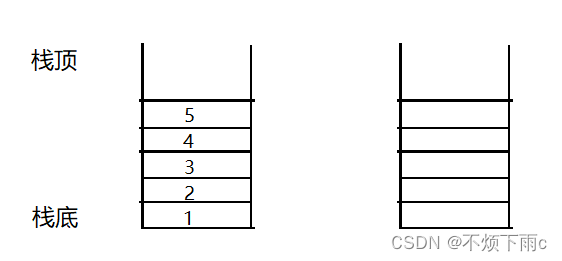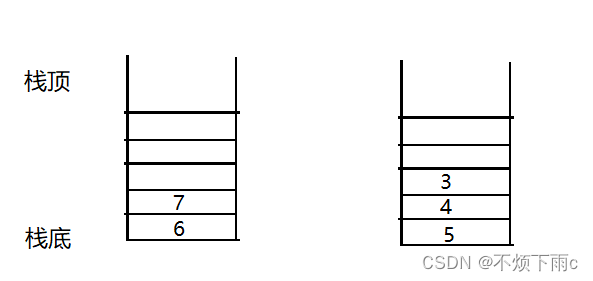题目描述:
请你仅使用两个栈实现先入先出队列。队列应当支持一般队列支持的所有操作(push、pop、peek、empty):
实现 MyQueue 类:
void push(int x)将元素 x 推到队列的末尾int pop()从队列的开头移除并返回元素int peek()返回队列开头的元素boolean empty()如果队列为空,返回true;否则,返回false
说明:
- 你 只能 使用标准的栈操作 —— 也就是只有
push to top,peek/pop from top,size, 和is empty操作是合法的。 - 你所使用的语言也许不支持栈。你可以使用 list 或者 deque(双端队列)来模拟一个栈,只要是标准的栈操作即可。
题目链接:力扣(LeetCode)官网 - 全球极客挚爱的技术成长平台
功能思路:
在实现本题前,需要先构建好栈的基本功能,可以参考:http://t.csdnimg.cn/Kha16
1.出队列 和 入队列
现在我们有两个栈,假设在第一个栈中依次入栈1 2 3 4 5,另一个为空栈

现在要出队列的话,应该把1出队,所以需要把除了栈底元素的其他元素出栈并且入到第二个栈里,这时就可以将1出队,但是将数据导入另一个栈时,数据会倒过来

如果要再次出队列的话,应该把2出队,就不需要把数据导一次了,直接栈顶出栈即可.
若此时再入队6 7的话,可以直接把6 7入到第一个栈中,因为出栈可以直接再第二个栈中操作

所以我们可以把将一个栈专门用来入数据,另一个栈专门用来出数据,每次出队之前先判断出数据的栈是否为空,如果出数据那个栈不为空的话,直接出数据即可,否则就将入数据的栈中的数据导入出数据的栈中,再出栈.
2.返回队列开头元素
如果出数据的栈不为空,栈顶元素即为队列开头元素,否则就需要将入数据的栈的元素导入出数据的栈中,在返回栈顶元素
3.判空
两个栈同时为空,说明队列为空
参考代码:
typedef int STDataType;
typedef struct stack
{
int* a;
int top;
int capacity;
}ST;
void STInit(ST* ps)
{
assert(ps);
ps->a = NULL;
ps->capacity = 0;
ps->top = 0; //top初始化位0,top的值可以表示栈元素的个数
}
void STPush(ST* ps, STDataType x)
{
assert(ps);
//扩容
if (ps->top == ps->capacity)
{
int newcapacity = ps->capacity == 0 ? 4 : ps->capacity * 2;
STDataType* ret = (STDataType*)realloc(ps->a,sizeof(STDataType)*newcapacity);
if (ret == NULL)
{
perror("realloc");
return;
}
ps->a = ret;
ps->capacity = newcapacity;
}
ps->a[ps->top] = x;
ps->top++;
}
void STPop(ST* ps)
{
assert(ps);
assert(ps->top);
ps->top--;
}
STDataType STTop(ST* ps)
{
assert(ps);
assert(ps->top);
return ps->a[ps->top - 1];
}
bool STEmpty(ST* ps)
{
assert(ps);
return ps->top == 0;
}
int STSize(ST* ps)
{
assert(ps);
return ps->top;
}
void STDestroy(ST* ps)
{
assert(ps);
free(ps->a);
ps->a == NULL;
ps->top = ps->capacity = 0;
}
typedef struct {
ST Queuepush;
ST Queuepop;
} MyQueue;
MyQueue* myQueueCreate() {
MyQueue *obj=(MyQueue*)malloc(sizeof(MyQueue));
STInit(&obj->Queuepush);
STInit(&obj->Queuepop);
return obj;
}
void myQueuePush(MyQueue* obj, int x) {
STPush(&obj->Queuepush,x);
}
int myQueuePeek(MyQueue* obj) {
if(STEmpty(&obj->Queuepop))
{
while(!STEmpty(&obj->Queuepush))
{
STPush(&obj->Queuepop,STTop(&obj->Queuepush));
STPop(&obj->Queuepush);
}
}
return STTop(&obj->Queuepop);
}
int myQueuePop(MyQueue* obj) {
int front = myQueuePeek(obj);
STPop(&obj->Queuepop);
return front;
}
bool myQueueEmpty(MyQueue* obj) {
return STEmpty(&obj->Queuepop)&&STEmpty(&obj->Queuepush);
}
void myQueueFree(MyQueue* obj) {
STDestroy(&obj->Queuepop);
STDestroy(&obj->Queuepush);
free(obj);
}